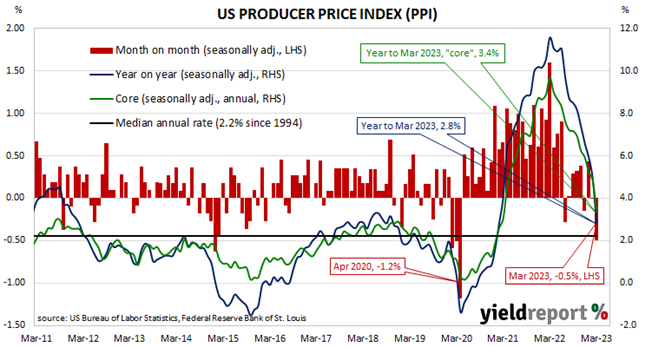Summary: US producer price index (PPI) down 0.5% in March, less than expected; annual rate slows to 3.4%; “core” PPI down 0.1%; fall attributable to 11.6% gasoline price drop; longer-term Treasury yields up; rate-rise expectations soften; goods prices down 1.0%, services prices down 0.3%.
Around the end of 2018, the annual inflation rate of the US producer price index (PPI) began a downtrend which continued through 2019. Months in which producer prices increased suggested the trend may have been coming to an end, only for it to continue, culminating in a plunge in April 2020. Figures returned to “normal” towards the end of that year but annual rates through 2021 and 2022 have been well above the long-term average.
The latest figures published by the Bureau of Labor Statistics indicate producer prices decreased by 0.5% after seasonal adjustments in March. The fall was in contrast with a flat outcome which had been generally expected as well as February’s flat result after it was revised up from -0.1%. On a 12-month basis, the rate of producer price inflation after seasonal adjustments and revisions slowed from 5.0% in February to 2.8%.
Producer prices excluding foods and energy, or “core” PPI, declined by 0.1% after seasonal adjustments. The result contrasted with the expected 0.2% increase as well as February’s 0.2% rise and the annual rate slowed from February’s revised figure of 4.9% to 3.4%.
“The fall in the headline print was attributable to a 6.4% drop in energy costs, which can mainly be traced back to an 11.6% drop in the price of gasoline,” said ANZ Head of FX Research Mahjabeen Zaman.
Longer-term US Treasury bond yields rose on the day. By the close of business, the 10-year Treasury yield had gained 5bps to 3.45% and the 30-year yield had added 6bps to 3.69%. The 2-year yield finished 1bp lower at 3.96%.
In terms of US Fed policy, expectations of a higher federal funds rate over the next few months softened a touch while expectations of rate cuts further out firmed slightly. At the close of business, contracts implied the effective federal funds rate would average 4.83% in April, in line with the current spot rate, and then climb to an average of 4.99% in May. June futures contracts implied a 5.005% average effective federal funds rate while April 2024 contracts implied 3.91%, 92bps less than the current rate.
The BLS stated higher prices for final demand good fell by 1.0% on average. Prices of final demand services fell by 0.3%.
The producer price index is a measure of prices received by producers for domestically produced goods, services and construction. It is put together in a fashion similar to the consumer price index (CPI) except it measures prices received from the producer’s perspective rather than from the perspective of a retailer or a consumer. It is another one of the various measures of inflation tracked by the US Fed, along with core personal consumption expenditure (PCE) price data.


